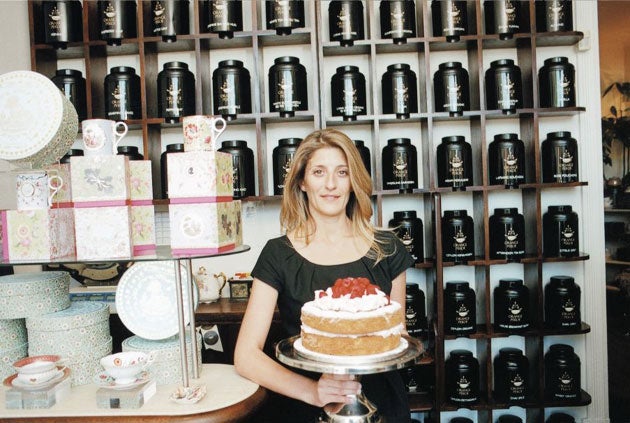Fancy restaurants are going to the wall. Could this be the perfect time to open a tearoom?
Orange Pekoe: 3 White Hart Lane, London SW13, tel: 020 8876 607

So it has come to this. Reviewing a tearoom. What is the world coming to? Its senses? Because if this crisis doesn't bring back the tearooms of yore, then I don't know what will. We don't want Burgundy and foie gras, we want a nice cuppa and a scone.
As if they could see this whole thing coming, Marianna Hadjigeorgiou and Achilleas Agridiotis have knitted together an idyllic little tearoom on a sunny riverside street corner in villagey Barnes, south-west London. Walls are lined with glossy tea canisters, while a marble-topped wooden counter is laden with cake stands and glorious-looking Konditor & Cook creations under a romantic chandelier. Tucked in behind are three little rooms with white brick walls, wooden tables, kitsch tea cosies and darling little floral cups and saucers set on wooden panels as if caught mid-throw.
The simple, no-nonsense food runs to salads, house-made pies, pâté and cheese platters, cakes and scones, eggy breakfast options, and a vast array of made-to-order sandwiches. I order two sarnies on doorstopper-thick wholemeal bloomer – one of moist, hand-carved Cypriot lounza ham and good cheddar (£4.50), the other of moist, lightly smoky salmon and lettuce (£5.10). Both are a million miles from the over-refrigerated, overpackaged high-street strain.
Less successful is a bowl of minestrone soup (£4.70) that isn't canned, but tastes as if it is, and a dull, solid wedge of cold chicken, asparagus and ham pie (£7.50). Looking on the bright side – as we all must – this just leaves more room for cake and scones. Hurrah!
A fruit scone comes with a little bowl of good jam and a big dollop of crusty clotted cream, for £2. It is, quite simply, a beautiful thing; fresh and light, with none of the nasty bicarb aftertaste that has marred my last nine-trillion scones. A slice of home-made walnut and coffee cake (£3) also has a fine, moist crumb, without the gratuitous whipped cream or fashionable high-rise icing that ruins most contemporary baking.
And the tea? Having won the Time Out Award for London's Best Tea Room 2008, nobody here is about to toss a teabag into a mug any time soon. Indeed, water temperature and infusing times are particular to each tea, and tea leaves are removed before serving to maintain a consistent tea strength; all intelligent signs of respect for the only beverage that can save this nation from despair.
When I suggest Darjeeling, the manager frowns. "Will you be taking milk?" She recommends a feistier Ceylon, which soon arrives in a fat-bellied pot (£3.50), beautifully brewed, clear and harmonious, with hints of vanilla and smoke.
I believe there is coffee here, too, but that's not quite the point, is it? It was caffeine-fuelled, soy-milk latte-sippers who got us into this mess in the first place. It is tea, and tearooms such as this, that will help us get through it.
Score: 14/20
Scores 1-9 stay home and cook 10-11 needs help 12 ok 13 pleasant enough 14 good 15 very good 16 capable of greatness 17 special, can't wait to go back 18 highly honourable 19 unique and memorable 20 as good as it gets
Orange Pekoe: 3 White Hart Lane, London SW13, tel: 020 8876 6070
Breakfast, lunch and afternoon tea daily. Unlicensed.
Around £25 for two for lunch; £6.50pp for tea and cake
The way we were: room with a brew
By Kate Burt
In the 1950s, Lyons teashops were a high-street institution. With the need to blank out postwar gloom, but little money with which to do so, the British masses flocked to Lyons for a cup of tea, an affordable snack and a vital dose of escapism.
Having opened its first branch in 1894, the Lyons teashop chain was followed in 1909 by the Lyons Corner House, a cross between a food hall and a modern shopping mall. The scale was immense: each Corner House was spread over several floors with different restaurant styles on each – including the first Wimpy bars. Ground floors featured musical entertainment and a food hall, selling items served in the cafeteria, which was the heart of each Corner House.
Before the war, customers had had table service from uniformed waitresses. After it, the self-service cafeteria was born. Such was the popularity of the idea that, in the early 1950s, queue barriers were routinely installed to control the crowds eager to gain entrance.
Join our commenting forum
Join thought-provoking conversations, follow other Independent readers and see their replies
Comments